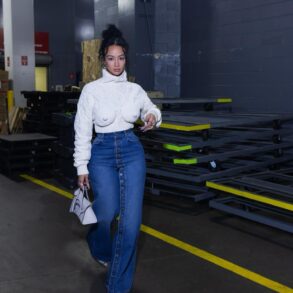Since opening its doors at Downtown Los Angeles’ L.A. Live Plaza in 2008, The Grammy Museum has celebrated hip-hop through various exhibits that have been educational and totally interactive. From celebrating the 25th Anniversary of the legendary Atlanta-based label So So Def to the life of Tupac Shakur through All Eyez On Me, the Recording Academy of the United States has evolved significantly in its respect for the culture. The Grammys have come a long way from Will Smith, DJ Jazzy Jeff, Salt n Pepa and L.L. Cool J boycotting the ceremonies in 1989 due to the Best Rap Performance award not being televised.
Turning 50 years old this year, The Grammy Museum has dedicated the entire 4th floor to hip hop’s historic rise with Hip-Hop America: The Mixtape Exhibit. The exhibit is open until Labor Day 2024 and was curated by four co-curators with a deep understanding of hip-hop culture including Felicia Angeja Viator, Adam Bradley, Jason King and Dan Charnas. According to Schyler O’Neal, who created educational programming for a 5,000-square foot installation alongside serving as Senior Education Manager at The Grammy Museum, the exhibit’s goal is to display how impactful hip hop has become and its influence in all contemporary music styles.
“Hip hop really has the ability to bring all different cultures together,” said O’Neal. “Seeing it more involved in what’s happening in the music landscape is just a natural progression of the impact that it has. And naturally we wanted to provide a place to tell that story and continue to build the legacy of it.”
Immediately before entering the exhibit, attendees are welcomed with a video projection featuring various hip-hop performances, such as Kendrick Lamar, Cardi B, Coolio, and the Hip Hop 50 melody curated by Questlove. Then there are artifacts like Lil Wayne’s 2009 Best Rap Album award for Tha Carter III and Flavor Flav’s iconic clock.
Once inside the exhibit, attendees can enter the Sonic Playground, where they can learn how to DJ or sample, listen to classic hip hop tracks through car speakers, portions that detail the culture’s early beginnings, view various artifacts from clothing to handwritten lyrics, interactive photo experience with exhibit presenter Google and much more.
However, O’Neal’s favorite exhibit has to be a working freestyle booth inspired by the classic BET series Rap City: Tha Basement. The Rap City activation couldn’t have come at a better time. BET recently released the first of a three-part Welcome To Rap City documentary that goes deep into the series’ effect on hip-hop culture. Featuring Big Tigger as a guide, attendees can rap alongside rap tunes by rappers like Reason or freestyle to beats made by producers like Hit-Boy, PERFXN and O’Neal.
“I actually got a chance to put together the rap city interaction,” said O’Neal. “I grew up on Rap City. When we began to talk about freestyling and all of that, I’m like it has to be Rap City. I actually got a chance to fly down to Atlanta and meet with Tigger where we recorded his part and some rappers.”
Throughout the time of the exhibit, there will be different educational workshops around hip-hop besides community engagement programs and panels. For O’Neal, the culture has affected the world outside of music, dance, art, and fashion. Hip-Hop America: The Mixtape Exhibit is academic in its approach to teaching hip-hop but with an undeniable flair that’s honestly inspiring.
“Hip-hop has made superstars in film, entrepreneurs, executives and bridged cultures together,” explained O’Neal. “For The Grammy Museum to be able to come in and highlight something like that 50 years ago people thought was a fad, it’s still in places here being elevated. I’m really proud to be part of this.”
This post was originally published on this site be sure to check out more of their content.






